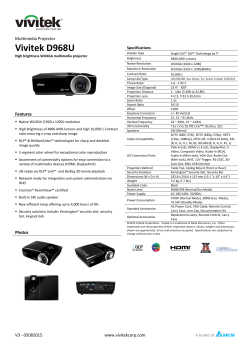
Mitsubishi WD57734 DLP Chip Replacement
Mitsubishi WD57734 DLP Chip Replacement Mitsubishi WD57734 DLP Chip Replacement This guide will detail the installation of a new DLP chip into the light engine of the TV. Replacing the chip will often remove stationary white and black spots that appear over time. Written By: David Sylvester TOOLS: Flathead 3/32" or 2.5 mm Screwdriver (1) PARTS: Mitsubishi 4719-001997 DLP Chip (1) Anti-Static Wrist Strap (1) Latex or nitrile gloves (1) Large Needle Nose Pliers (1) Phillips #0 Screwdriver (1) Phillips #1 Screwdriver (1) Phillips #2 Screwdriver (1) Phillips #00 Screwdriver (1) © iFixit — CC BY-NC-SA www.iFixit.com Page 1 of 8 Mitsubishi WD57734 DLP Chip Replacement Step 1 — Back Panel Remove the following 8 Phillips #1 screws: One 22 mm Phillips #1 in the bottom right corner of the back panel. One 18 mm Phillips #1 in the top middle of the back panel. Six 18 mm Phillips #1 in the rest of the back panel. Step 2 Pull the back panel off of the television by gripping the sides and rotating it down. © iFixit — CC BY-NC-SA www.iFixit.com Page 2 of 8 Mitsubishi WD57734 DLP Chip Replacement Step 3 — DLP Chip Disconnect the light engine power cable by holding its white tab and pulling straight back. Disconnect the four connections above the black data connection by gently pulling the plugs out of the sockets (some of the connections have a tab that must be pressed when pulling to disconnect). Step 4 Disconnect lamp ballast power and data connections in front of the light engine by pressing their corresponding tabs and pulling appart. Release the cables from the white cable ties by twisting the white cable clasps and pulling the cables out of the clasps. © iFixit — CC BY-NC-SA www.iFixit.com Page 3 of 8 Mitsubishi WD57734 DLP Chip Replacement Step 5 Loosen the two secured Phillips #00 screws securing the black data connection to the light engine. These two screws are attached to the connector and are not meant to be removed completely. Gently pull the black connector off the light engine. Step 6 Use pliers to remove the two securing bolts from above and below the data port by rotating counterclockwise. Remove the seven 8 mm Phillips #0 screws holding the plate to the light engine board. Gently hold each side of the metal frame and pull it straight back to reveal the board and heat sinks underneath. © iFixit — CC BY-NC-SA www.iFixit.com Page 4 of 8 Mitsubishi WD57734 DLP Chip Replacement Step 7 Disconnect the last connection from the light engine by holding the white tab and pulling straight back. Step 8 Remove the two 15 mm Phillips #0 screws holding the DLP heat sink to the light engine board. Springs underneath the screws help hold the heat sink on top of the DLP chip. During reassembly do not tighten the screws down all the way. Doing so can damage the DLP chip. © iFixit — CC BY-NC-SA www.iFixit.com Page 5 of 8 Mitsubishi WD57734 DLP Chip Replacement Step 9 Remove the five remaining 8 mm Phillips #0 screws. Step 10 Carefully pull the board to expose the two cables that connect to the back of the board. Use pliers and tweezers to disconnect the ribbon cable by pulling it straight out of its socket and the data connector by holding its tab and pulling it straight back from the board. Do not let the ribbon cable recede into the light engine. © iFixit — CC BY-NC-SA www.iFixit.com Page 6 of 8 Mitsubishi WD57734 DLP Chip Replacement Step 11 Lay board facedown on a smooth surface. Do not touch front of the dlp chip. Oils or dust will distort the tv image. Use a small flathead screwdriver to turn the locking screw half a turn counterclockwise Remove DLP chip from the light engine board by pulling straight back. Photo shows an example of a broken DLP chip with hundreds of stuck pixels. © iFixit — CC BY-NC-SA www.iFixit.com Page 7 of 8 Mitsubishi WD57734 DLP Chip Replacement Step 12 During reassembly after installing the new DLP chip, it is recommended that you remove the old thermal paste from the DLP heat sink with a thermal compound remover and purifier. After removing the thermal compound, apply a small amount of new thermal compound (about the size of a grain of rice) and use a card to apply it evenly over the surface of the heat sink that will be in contact with the chip. This will improve the cooling of the chip during use and will prevent overheating that caused failure of the old chip. To reassemble your device, follow these instructions in reverse order. This document was last generated on 2015-05-01 02:07:13 PM. © iFixit — CC BY-NC-SA www.iFixit.com Page 8 of 8
© Copyright 2025














